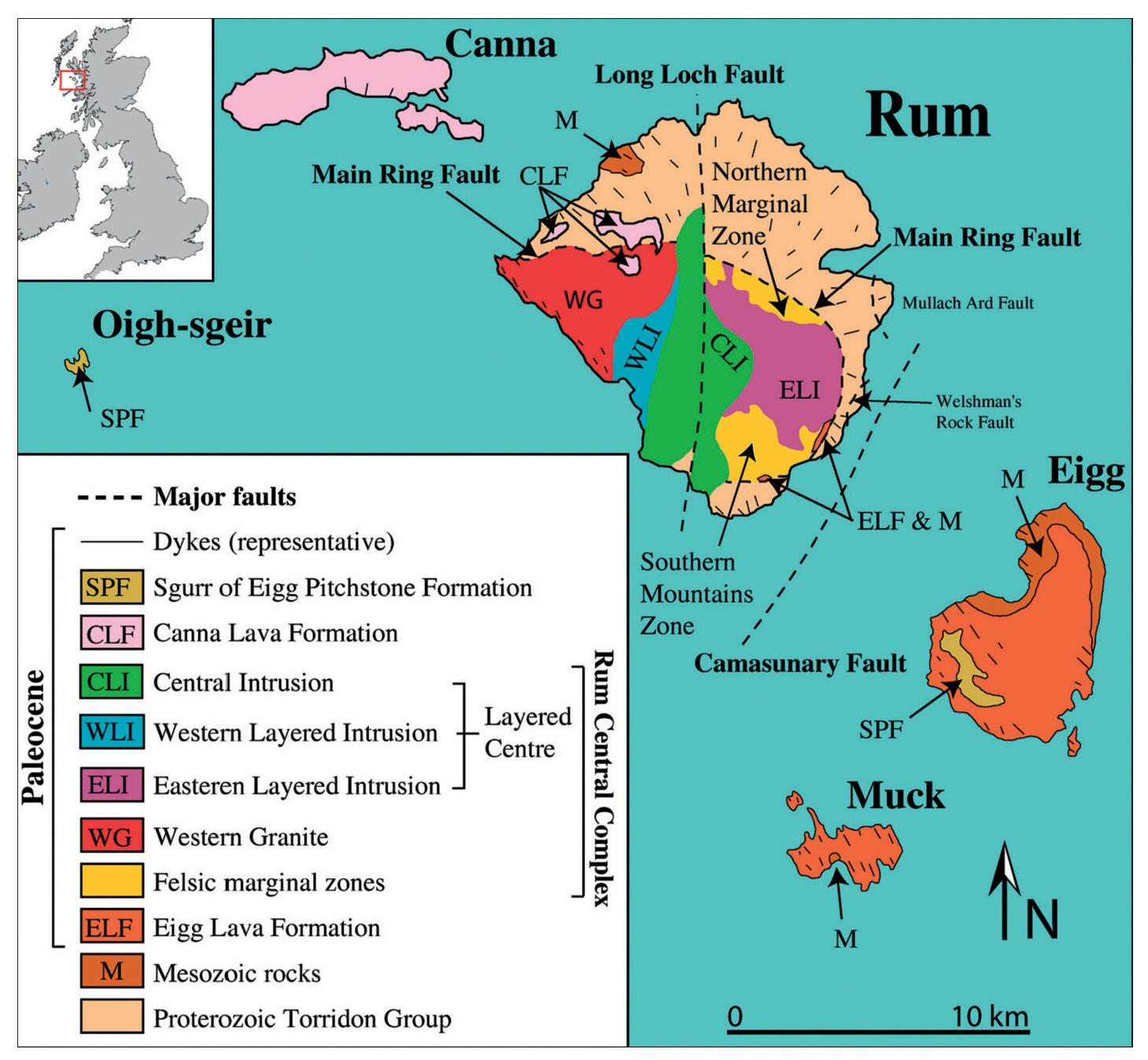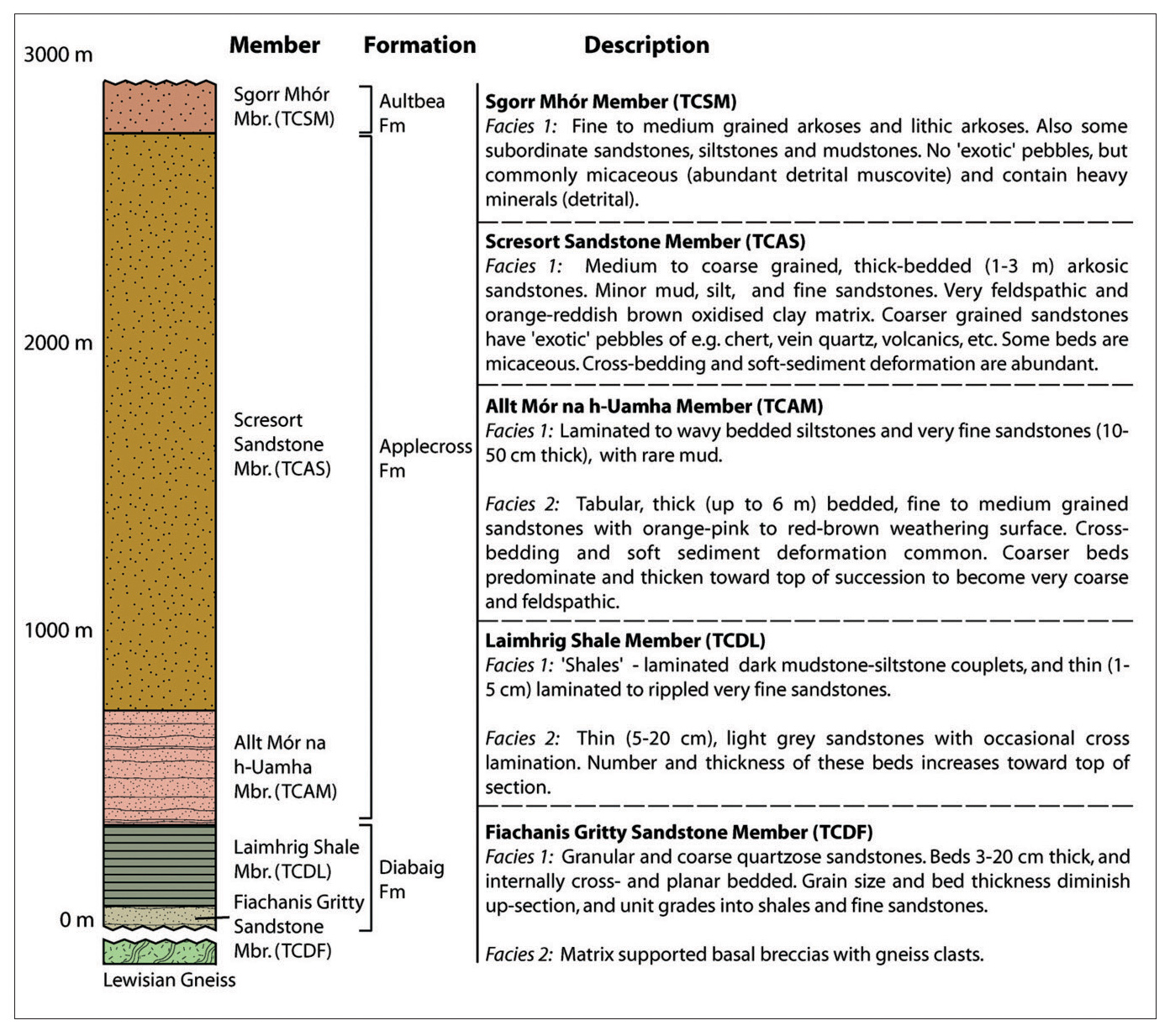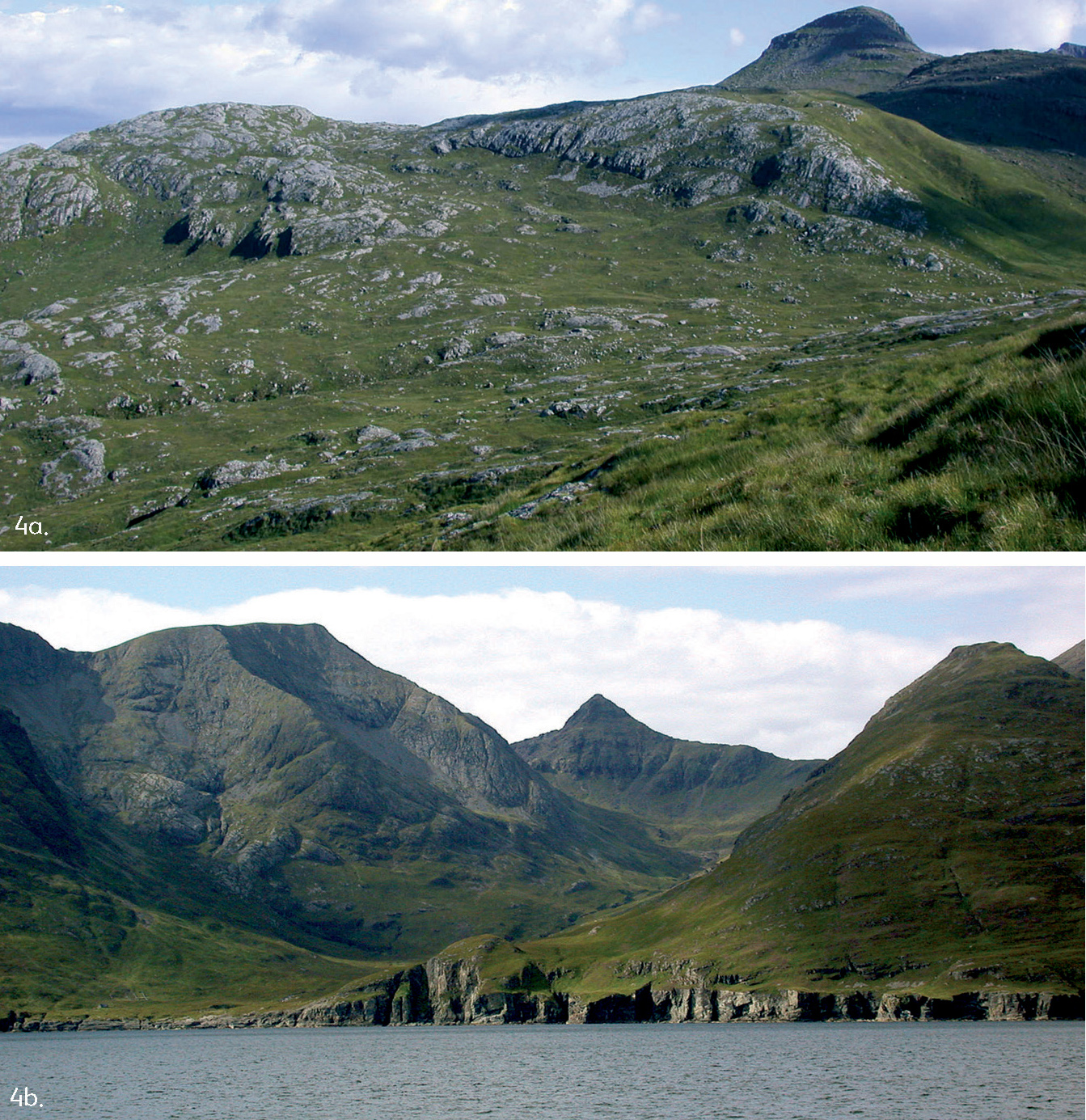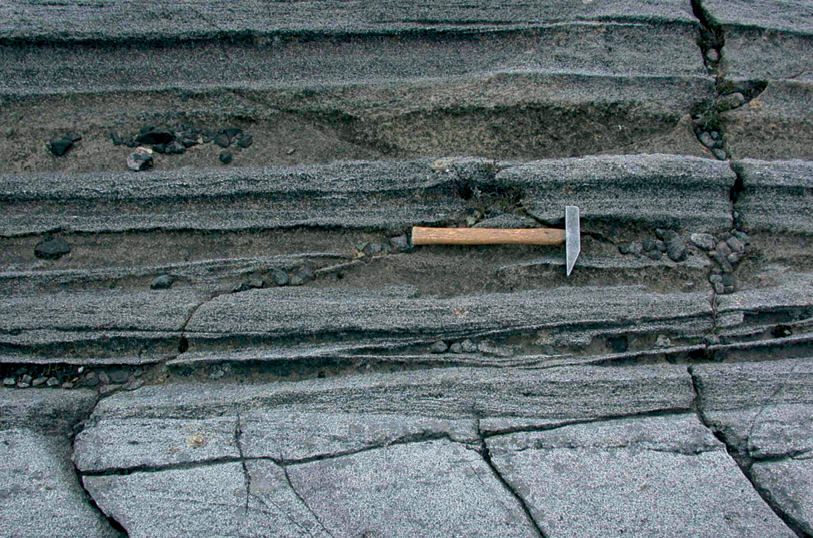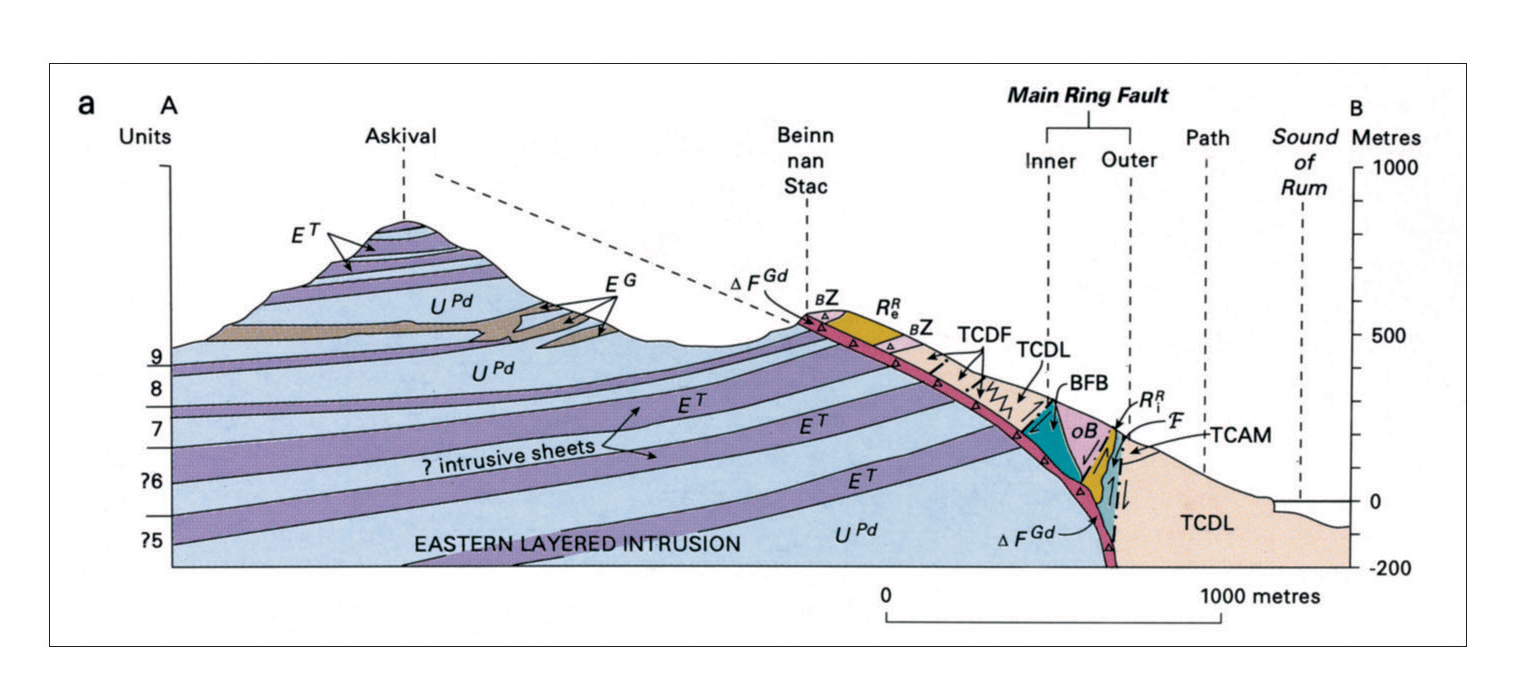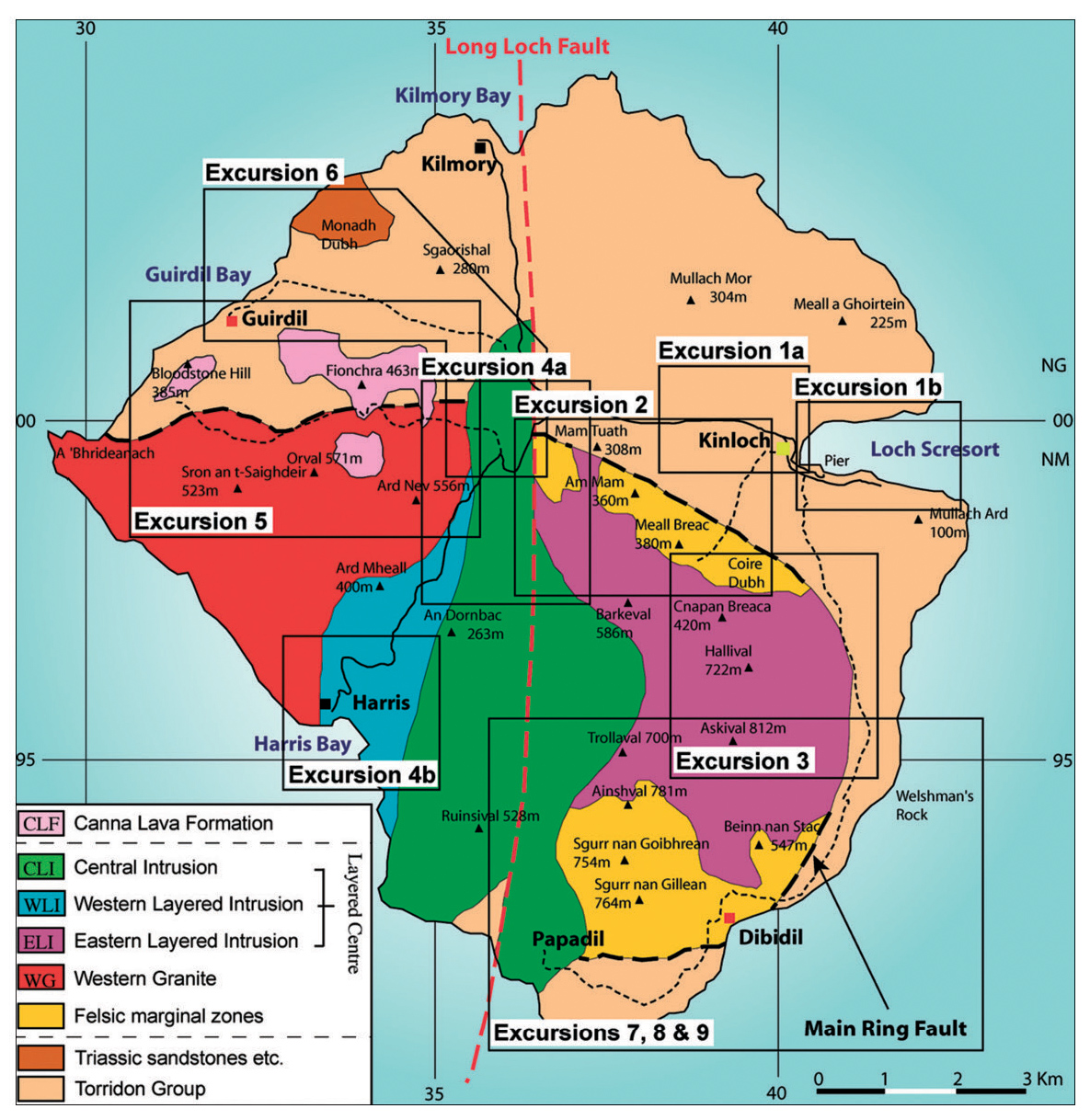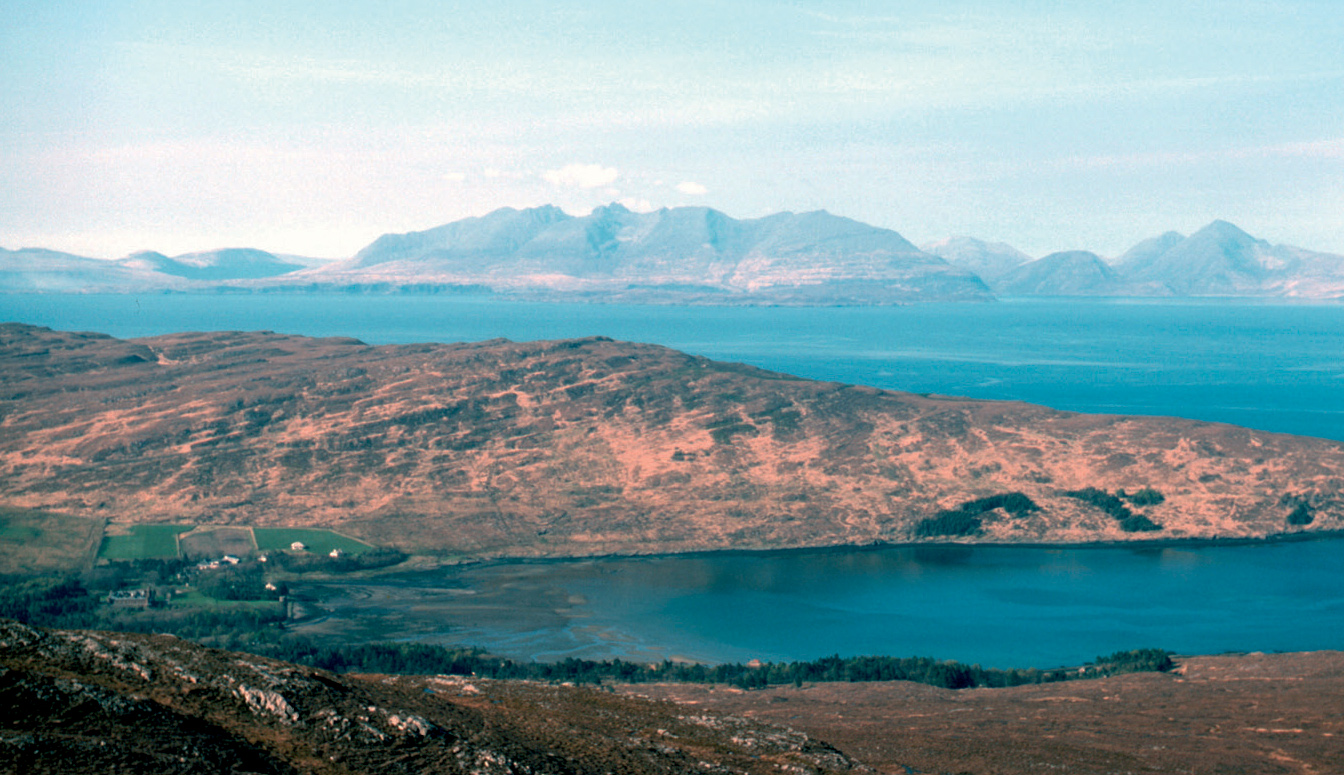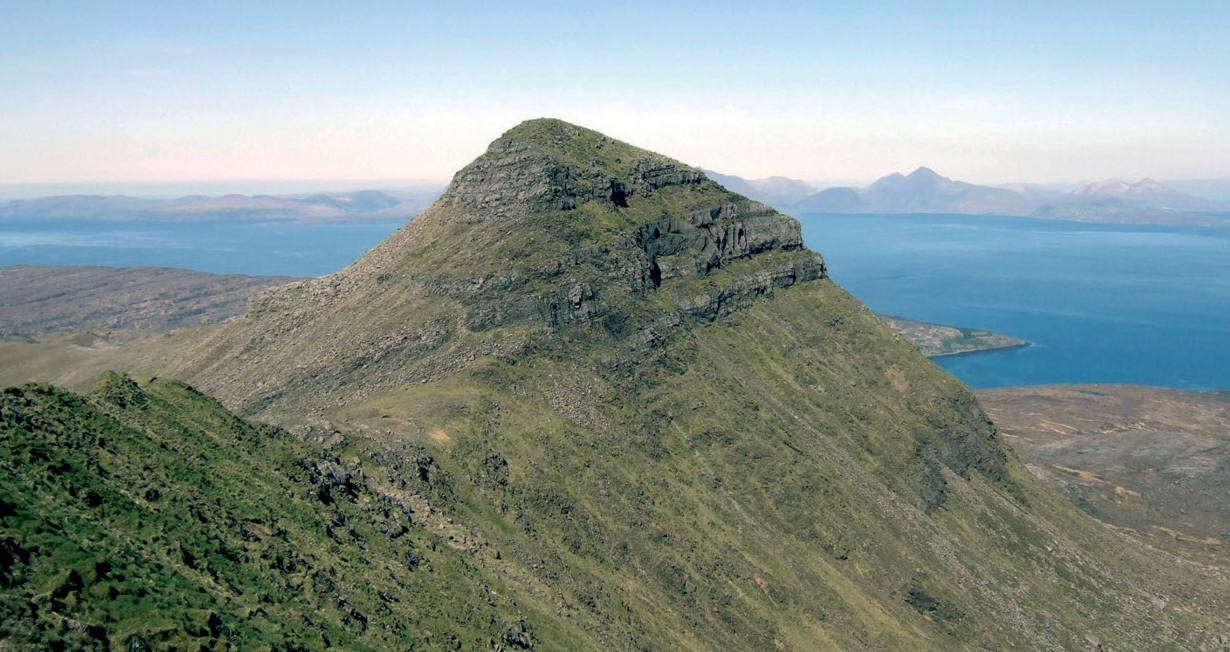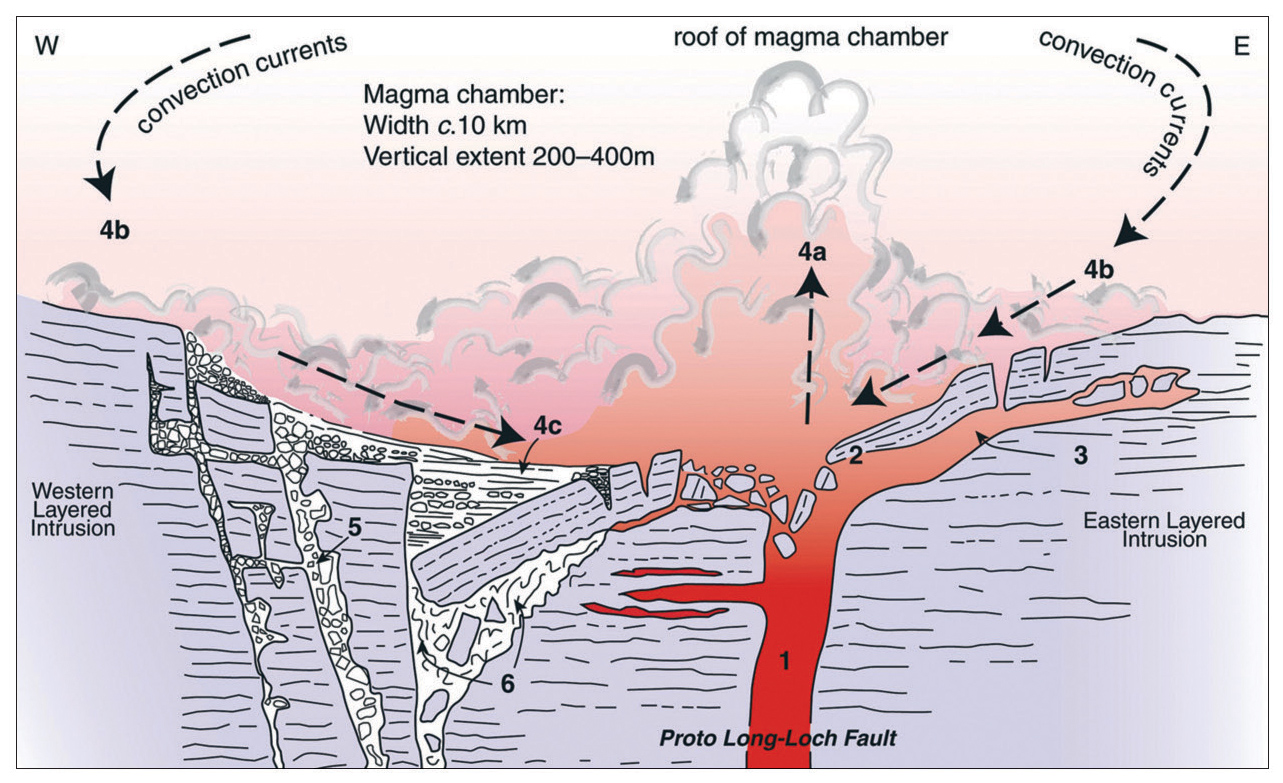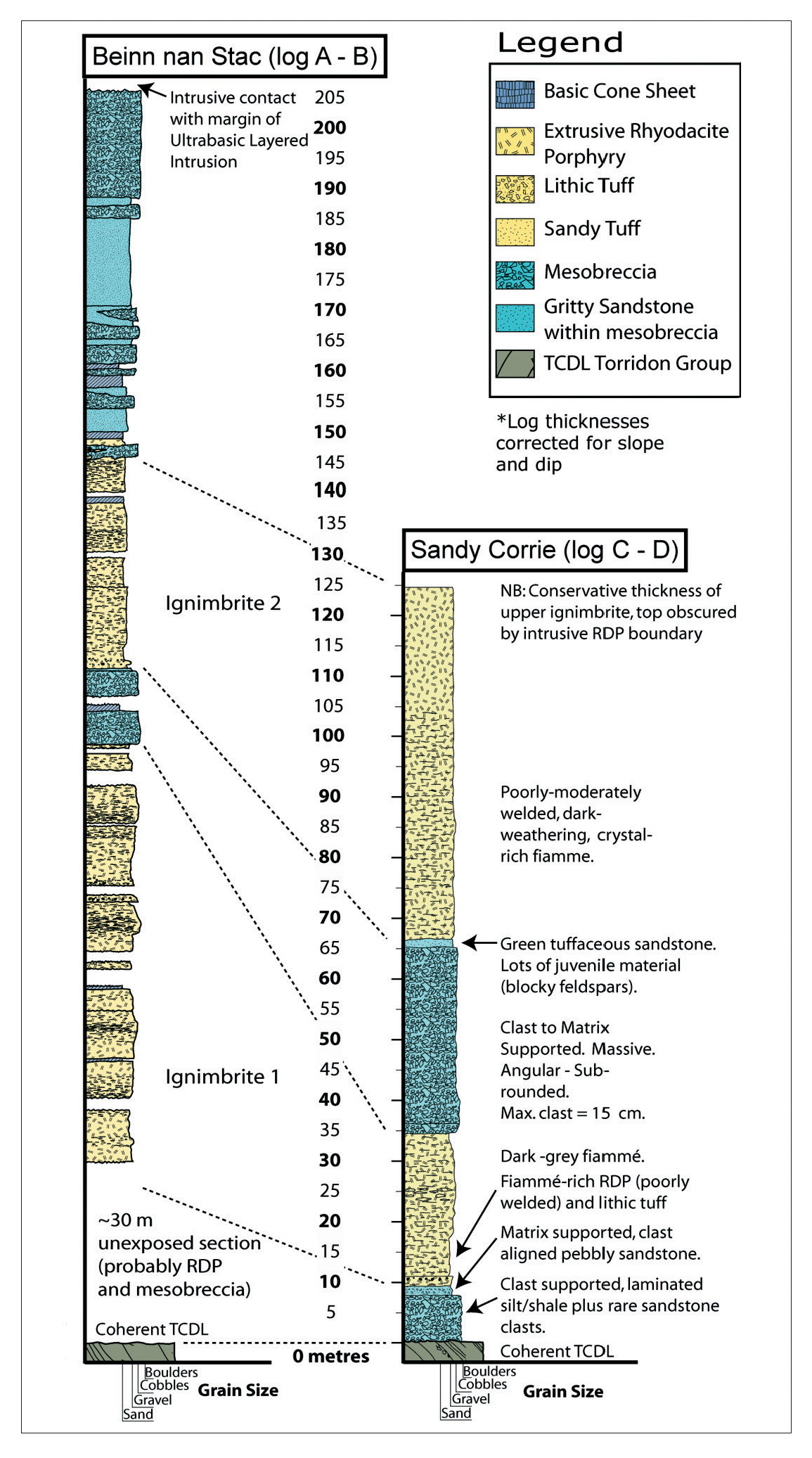Summary of the Geology of Rum
Introduction
The Paleocene
The
Table 1: Sequence of faulting, folding and intrusion in the
| Table: | Sequence of faulting, folding and intrusion in the |
| 1 | Pre-Palaeogene: tilt to west of Triassic and Torridonian strata; faulting in these successions; early movement on the Long Loch Fault? |
| 2 | Doming of the Torridonian strata around the central complex accompanied initial uplift, with formation of the Welshman's Rock and Mullach Ard faults as country rocks slid off the dome. Fault blocks broke up and behaved independently, the Welshman's Rock block rotating c.90°. |
| 3 | Initial uplift on the Main Ring Fault (MRF): Lewisian and basal Torridonian uplifted by as much as 2 km, also tilting of elevated block to the east. |
| 4 | Subsidence on the MRF: eruption of rhyodacite ash flows, intrusion of rhyodacite along the MRF, intrusion of tuffisites, collapse of caldera walls to form breccias and megabreccias, intrusion of the Am Màm Breccias; subsidence brings Broadford Beds and |
| 5 | Emplacement of the Western Granite (may have been associated with movement that formed the inner component of the MRF). |
| 6 | Final uplift on the MRF (inner component). |
| 7 | Emplacement of radial dykes, regional north-west-trending dykes, and cone sheets. |
| 8 | Formation of a Loch Scresort–Glen Shellesder Fault? |
| 9 | Emplacement of the Eastern and Western layered intrusions. |
| 10 | Emplacement of the Central Intrusion — re-activation of the Long Loch Fault? |
| 11 | Small radial faults within the Central Intrusion and Eastern layered intrusion. |
| 12 | Accumulation of the |
| 13 | Long Loch Fault (final movement); faults in |
Stage 2 commenced with the intrusion of a set of basaltic cone-sheets and numerous basaltic dykes, many of which trend north-west to north-north-west and belong to the Rum Dykeswarm. Emplacement of the Rum Layered Centre (feldspathic peridotites, troctolites and gabbros) followed. On Hallival and Askival, in eastern Rum, these mafic and ultrabasic rocks form prominent, gently-dipping layers (generally termed 'Units') and comprise the Eastern Layered Intrusion (formerly 'Series'). Layered rocks also occur in south-west Rum where they form the Western Layered Intrusion. The Central Intrusion separates the Western and Eastern layered intrusions. This comprises a north–south belt of igneous breccias composed of blocks and megablocks of bytownite troctolite and feldspathic peridotite enclosed in matrices of similar compositions. The Central Intrusion is regarded as the feeder system for the Layered Centre. It is located along a major north–south fracture, the Long Loch Fault. Numerous sheets and plugs of gabbro and feldspathic peridotite intrude the layered rocks, and they are also found as plugs throughout the country rocks. A few dykes, including rare picrites, also intrude the Layered Centre.
After Stage 2: a major volcanic edifice was likely built over Rum during stages 1 and 2, but subsequent (and probably also contemporaneous) erosion rapidly reduced this to a hilly landscape. Evidence for this comes from north-west Rum where the Western Granite and sandstones of the
There is a gap in the geological record from the Paleocene until the Pleistocene Epoch, when the island was almost completely covered by the Main Late Devensian ice sheet sourced in mainland Scotland. At a later stage, during the Loch Lomond Stadial, it supported a local ice cap with several valley glaciers. The ice had gone by about 11,500 BP and there is evidence that Man arrived fairly soon thereafter; at Kinloch a recently excavated site yielded implements made from the bloodstone found in the lavas of north-west Rum. Remains from this site have been dated at about 8,500 BP.
Pre-Paleocene Geology
Lewisian Gneiss Complex
Archaean gneisses crop out along and within the Main Ring Fault (Figure 2; Tilley 1944; Bailey, 1945, 1956). They include interbanded felsic and mafic varieties and amphibolites after original mafic dyke or sheet intrusions. The outcrops are generally fault-bounded or cut by later intrusions but at a few localities gneiss is unconformably overlain by coarse-grained sandstone at the base of the local Torridonian succession; for example, in Sandy Corrie
Torridon Group
The group is part of the more extensive Torridonian succession found on the mainland and is represented on Rum by a succession of sandstones, siltstones and, locally, sedimentary breccias totalling at least 2500 m in thickness, and several of the mainland formations are recognised
Medium- to fine-grained feldspathic sandstones of the
Mesozoic strata
Sedimentary breccias, gritty sandstones and calcareous sandstones and siltstones of the Triassic
Coarse-grained grey marble, calc-silicate hornfelses, quartzite and baked mudstones crop out south of Allt nam Bà and on the northern slopes of Dibidil. Poorly preserved fossils of Early Jurassic age have been recovered from these rocks which are correlated with the Broadford Beds of Skye (Smith, 1985). These beds are preserved in fault-bounded slices on the Main Ring Fault. At Allt nam Bà, where they are in contact with Marginal Gabbro of the central complex, the hornfelsed rocks contain the calc-silicate minerals spurrite, tilleyite and harkerite, indicating high-grade sanidinite-facies thermal metamorphism (Excursion 7; Hughes, 1960b; Emeleus, 1997).
Paleocene
Pre-Stage 1
Basaltic lavas belonging to the
It is likely that some of the numerous north-west- to west-north-west-trending basaltic dykes that intrude the Torridonian beds pre-date the central complex since these and less common sheets are affected by movements on the Main Ring Fault. However, conclusive proof is elusive and the majority of the dykes on Rum probably belong to the early part of Stage 2 (see below).
The Rum Central Complex
Stage 1
The Am Màm Breccias
Evidence for some of the earliest activity within the central complex comes from the Am Màm Breccias in the Northern Marginal Zone (Table 1, page 8; Excursion 2). The breccias consist of abundant angular blocks in dioritic to granodioritic matrices, with textural relationships that suggest there has been mixing of felsic and mafic magmas. The xenoliths are commonly less than 1 m across but may be many metres in width. They comprise angular blocks of very coarse-grained gabbro, dolerite, rare feldspathic peridotite, baked sandstone and gneiss, and, additionally, there are small (up to 10 cm) rounded doleritic inclusions with diffuse margins. Areas of very coarse-grained gabbro several tens of metres in diameter are identical to gabbro fragments in the breccias. Gabbros east and west of Am Màm hill are cut by veins and more substantial bodies of breccia and maintain their coarse-grained character throughout, generally lacking any indications of chilled margins except at one locality east of Loch Gainmhich where gabbro grades into finer grained rocks at a contact with thermally metamorphosed Lewisian gneiss (pyroxene hornfels). These large areas of gabbro were previously considered to be plugs (e.g. Dunham, 1968) but are now interpreted to be megablocks in the Am Màm Breccia. Similar igneous breccias are present in the Southern Mountains Zone.
The Coire Dubh Breccias
Coarse sedimentary breccias feature prominently in both the Southern Mountains Zone (SMZ) and their type locality, the Northern Marginal Zone (NMZ), where they crop out abundantly in Coire Dubh, between Meall Breac and Cnapan Breaca (Excursion 2;
Despite their close proximity on the south side of Am Màm (at c.
The two breccias are of very different origins. The Am Màm Breccia is intrusive and has a thoroughly igneous matrix with the characteristics of a hybrid (mixed felsic/mafic) magma, whereas the Coire Dubh Breccia formed from debris that accumulated against the walls and on the floor of a caldera (Emeleus, 1997; Troll et al., 2000; Donaldson et al., 2001).
Porphyritic Rhyodacite
Large bodies of porphyritic rhyodacite (the 'porphyritic felsite' of Hughes, 1960a and Dunham, 1968) crop out in both the NMZ and the SMZ
Streaky, banded structures in the rhyodacite (fiamme) occur on both outcrop and microscopic scales (Excursion 2). The banding was formerly attributed to the flow of viscous, degassed felsic magmas, but it is now recognised that the structures closely resemble fiamme and, in the devitrified glassy matrices, relict shards are readily recognised. Additionally, phenocrysts are commonly broken, and small, rounded pieces of basalt (< 1 cm diameter) are scattered throughout the rock. The rocks are now interpreted to be pyroclastic flow deposits that erupted from vents on or near the Main Ring Fault and accumulated on the floor of a caldera (Williams, 1985; Donaldson et al., 2001). On Meall Breac, a flow feeder at the north end of the ridge has close-set, near-vertical banding (highly-attenuated fiamme) and may be traced southwards into a thick, extrusive mass of rhyodacite overlying the Coire Dubh Breccia. Nearby, on a shelf north of Meall Breac, a dyke-like mass of porphyritic rhyodacite cuts the Am Màm Breccia (Excursion 2). A few small intrusive bodies of porphyritic rhyodacite crop out on the Main Ring Fault and on the south-east slopes of Beinn nan Stac and in Coire Dubh.
Tuffisites
Irregular, thin (< 30 cm), dark-coloured dykes cut sandstones and the Coire Dubh Breccia in Coire Dubh and Dibidil. The dykes are generally xenolith-rich, with abundant small fragments of country rock and rare, bleb-like pieces of porphyritic rhyodacite. Microscopic examination shows the presence of rounded mafic inclusions with a fluidal structure, banded rhyodacite, altered basalt and dolerite, and crystals of quartz and zoned plagioclase similar to those in the rhyodacite. The dykes are examples of tuffisites. They either just pre-date the rhyodacite or are contemporaneous with it, and may represent the earliest rhyodacite magma cracking through to the surface, although this remains speculative (Excursions 2, 7 and 8).
Microgranites
The hills and coastal cliffs of west and south-west Rum are formed by the Western Granite, an intrusion of granophyric microgranite. Other small areas of microgranite occur near the Priomh-lochs (the Long Loch Granite) and on the south-west of Sgurr nan Gillean (the Papadil Granite, Excursion 9). The rocks are pale-brown or cream coloured, with small feldspar phenocrysts and drusy cavities visible on weathered surfaces. The phenocrysts are zoned plagioclase and the matrix is commonly microgranitic or of granophyrically intergrown quartz and dusty alkali feldspar. Pyroxenes (ferroaugite and ferropigeonite) are the principal mafic minerals, although both show varying degrees of replacement by amphibole and chlorite. A pale-weathering, cream-coloured variant of the granite near Harris contains fayalitic olivine and ferrohedenbergite. This may be a later member and, elsewhere, internal contacts have been noted.
The northern margin of the Western Granite is defined by the later Main Ring Fault. In the east, it is cut by mafic rocks belonging to Stage 2. Original intrusive contacts are limited to a small patch of thermally altered gneiss on the summit of Ard Nev and a strip of gneiss between the microgranite and feldspathic peridotite between Ard Nev and Ard Mheall. To the north-west, on Orval, lava flows belonging to the
The Main Ring Fault
The Main Ring Fault comprises a number of arcuate faults that define the outer margins of Stage 1 and were probably utilised in part during emplacement of Stage 2
Movement on the Main Ring Fault was complex. The earliest events are most clearly visible on the northern edge of the NMZ and in the vicinity of Allt nam Bà and Beinn nan Stac. Here, Lewisian gneiss and basal members of the
Throughout most of its length the Main Ring Fault appears to be either essentially vertical or steeply inclined towards the central complex. Inward-dipping components of the system occur on the eastern slopes of Beinn nan Stac, and between the Bealach a' Bhràigh Bhig south of Fionchra and the western tip of Rum at A' Bhrìdeanach.
In eastern Rum several large masses of Torridonian strata have also been displaced along low-angle faults. The most obvious of these blocks is the steeply-dipping mass of sandstone (
The southern tip of Rum, from Rubha nam Meirleach to the Main Ring Fault on the south of Sgurr nan Gillean, is formed by sandstones of the Sgorr Mhòr Sandstone Member and uppermost
Minor intrusions: the commencement of Stage 2
Minor intrusions are abundant on Rum. Dykes are the most common, but there are also numerous plugs and cone-sheets, and less-common conformable sheets and sills. Almost all of the dykes are basaltic in composition. They generally lack distinctive characteristics in the field, although 'big-feldspar' and picritic varieties are readily recognisable. Dykes generally range in width from 0.2 m to 1.5 m. Over forty gabbro and peridotite plugs have been mapped, varying in size from 20 m up to 500 m. These are particularly abundant in the sandstones in the north and north-west of Rum and appear to radiate from the central complex (Excursion 6). The gabbros are generally olivine free and may be considerably altered. The peridotite plugs include feldspathic varieties and rare dunites. Bleaching and thermal metamorphism of the adjoining sandstones is common and is especially pronounced next to the gabbroic intrusions where some partial melting of country rocks has occurred (e.g. Holness, 1999).
The majority of the minor basaltic intrusions probably post-date both the Main Ring Fault and Stage 1 (but see Excursion 7). The cone-sheets are apparently unaffected by the Main Ring Fault, for example north-west of Am Màm, and they post-date deformation of the
Conformable basaltic sheets intrude members of the
It is difficult to determine when the plugs were intruded since few cut or are cut by dykes and none can be shown to be faulted. Gabbro and peridotite plugs do, however, cut the Main Ring Fault (e.g. near the Priomh-lochs; Excursion 2) and the Layered Centre (e.g. on Cnapan Breaca [Excursion 2] and Beinn nan Stac) and some of the plugs are amongst the latest intrusions in Stage 2. The elongate peridotite plugs in north-west Rum have a radiating pattern and appear to fan out from the Long Loch area, the possible site of the major feeder of the Layered Centre (see below). They frequently exert significant thermal influence on their immediate surroundings, e.g. Torridonian sandstone lithologies (cf. Holness, 1999, 2002).
Stage 2: The Layered Centre (formerly the 'Layered Suite')
Intrusions of feldspathic peridotite, bytownite troctolite (allivalite) and gabbro form the core of the
The Eastern Layered Intrusion (ELI)
The layered character of mafic rocks in the Layered Centre is most apparent in this intrusion in which a succession of gently dipping sheets of peridotite, allivalite and gabbro are magnificently exposed on Askival, Trollaval, Hallival and Barkeval
Up to sixteen layered units have been recognised
These interpretations were subsequently shown to be somewhat simplistic (e.g. Bedard et al., 1988; Renner and Palacz, 1987). Several sheets of feldspathic peridotite intrude troctolite (Excursion 3) and there are instances of apparent intrusive behaviour by bytownite gabbro ('eucrite') that had been mapped as parts of units (Holness, 2005). Many of the layered rocks do, however, contain structures simulating those found in clastic sedimentary rocks. Of these, the most obvious is the layering, analogous to sedimentary bedding but in which the 'beds' generally reflect differences in modal mineralogy rather than grain size. Others include slump and load structures and rare cross-bedding
and later magmatic fluids generated, for example, from (or by) intruding peridotites (cf. Bedard et al., 1988; Volker and Upton, 1990, 1991; Emeleus, 1997 and references therein; Holness, 2005; O'Driscoll et al., 2007b). Structures resembling those found in highly deformed and sheared metamorphic rocks are also present, occurring especially in the more feldspathic troctolites. These distinctive rocks may have resulted from mass flow of poorly consolidated crystal mushes. Good examples are found in Units 13 and 14 close to the path on the north-west shoulder of Hallival (Excursion 3). The layered rocks represent the crystallised products of high-temperature magmas that cooled and consolidated over an appreciable time span; it is therefore most likely that early-formed structures and textures will have been modified and overprinted by later events, some of which were likely analogous to diagenesis in sediments. Present investigations are gradually unravelling these complex events (e.g. Holness, 2005; Holness et al., 2005; Holness, 2007; Holness et al., 2007a, b; O'Driscoll et al., 2007a, b).
The Western Layered Intrusion (WLI)
This intrusion is largely composed of layered feldspathic peridotite, underlain by layered gabbro at Harris Bay (Wadsworth, 1961; Excursion 4b). The large-scale layering common throughout the ELI is less obvious in the WLI but small-scale layering is well developed and usually reflects variations in the proportions of olivine and plagioclase, sometimes accompanied by size variation and crystal lamination. In an unusual variety of layering, commonly up to 1 m in thickness, elongate crystals of olivine tens of centimetres in length appear to have grown upwards from a substrate of granular olivine, giving rise to 'harrisitic' textures (Figure 7, Excursion 4b). Good examples may be examined on the benches and low cliffs near the Harris Bay mausoleum, where harrisitic layers extend to within a metre or less of the edge of the intrusion (Excursion 4b). Excellent examples also occur on the southern slopes of Ard Nev and in exposures east of Ard Nev where small harrisitic olivines are present in layered peridotites, which also contain laminated layers with abundant platy olivine apparently broken off the tips of harrisitic olivines. The harrisitic olivines are considered to have grown rapidly from a fast-cooling magma supersaturated in olivine (e.g. Donaldson, 1974, 1976; O'Driscoll et al., 2007a).
The Central Intrusion (CI)
This intrusion intrudes both the Eastern and Western layered intrusions
A distinctive structure is found in feldspathic peridotites north-east of Loch MacIver (Loch an Dornabac). Radiating, bifurcating crystals of plagioclase up to 40 cm in length, enclosing myriads of minute olivine crystals, occur in seaweed-like masses as much as 1 m in diameter, scattered through the normal feldspathic peridotite. These 'poikilo-macro-spherulitic' feldspars grew in situ, possibly from a hydrous feldspathic magma (Excursion 4; Donaldson et al., 1973). Other cases of in-situcrystallisation are apparent in the CI and around Harris where radiating crystals of olivine reach lengths of up to several tens of centimetres (cf.
During the original survey of Rum (Harker, 1908), many instances were found where the peridotites, troctolites and gabbros in the Layered Centre had been intruded by 'granophyre' (microgranite) and 'felsite' (porphyritic rhyodacite) from which it was concluded that the felsic rocks were the younger. At first sight the field evidence seems incontrovertible: wherever the mafic rocks are in contact with felsic rocks, there are spectacular breccias in which angular to subrounded mafic rocks are embedded in a network of veins and dykes of fine- to medium-grained microgranite that merge into the adjoining felsic rocks (Excursion 4). Many years later this interpretation was challenged and it is now known that the breccias are intrusion breccias, formed when hot mafic magmas chilled against but also melted or partially melted silicic country rocks. These were principally microgranite and porphyritic rhyodacite, but also sandstones and feldspathic gneisses (Hughes et al., 1957; Hughes, 1960a; Emeleus, 1997). The relatively low-temperature, rheomorphic felsic melts had burst through and fragmented the chilled and contracting margins of the mafic intrusions, producing (rare) sinuous, rounded liquid-liquid contacts where still-liquid mafic magma chilled against the relatively low-temperature felsic liquids, while in some instances, hybrid rocks were formed when heated felsic magma was able to mingle with mafic magma. Thus, the rocks of the Layered Centre clearly post-date the felsic rocks of Stage 1
The scenario outlined above provides an explanation for the absence of good chilled margins to the constituents of the Layered Centre; they were simply destroyed during formation of the intrusion breccias (but see Greenwood et al., 1990). The problem is a general one throughout the Hebridean Igneous Province so that the most promising localities to search for good chills (possibly representing rapidly cooled parental magma) are at gabbro/basalt lava contacts, which are lacking on Rum. The problem of the parental magma or magmas of the Layered Centre has exercised investigators since the original survey (e.g. Harker, 1908; Brown, 1956; Emeleus, 1997 and references therein), with the present consensus favouring a magnesium-rich basalt, possibly most closely represented by rare picritic dykes that post-date the Layered Centre (Upton et al., 2002).
The Canna Lava Formation on Rum
Several small outliers of lava flows with interbedded conglomerates and gritty sandstones crop out on the hills of north-west Rum. These belong to the
These lavas post-date the
Accumulation of the
Events post-dating the Rum Central Complex
The Long Loch Fault
This fault extends in a general north–south direction across Rum
Numerous small faults occur throughout Rum. Some may be relatively early, as for example the north-east-trending fault that affects Torridonian beds on Bloodstone Hill but which is overlain by lavas. Others are of later date, as at West Minishal where lavas and conglomerates are cut by a north-north-west-trending fault that also offsets the MRF. Small, north-north-west-to north-north-east-trending faults also offset layering in the ELI north of Barkeval.
The Pleistocene and later
Rum was much affected by the Pleistocene glaciations and retains a record extending from at least 30,000 BP to the Holocene (Peacock, in Emeleus, 1997). The Main Late Devensian Glaciation enveloped Rum, when only the highest peaks formed nunataks. From the distribution of glacial striae and mainland erratics (mica schist and garnetiferous gneiss), which occur at heights of over 500 m on Barkeval and Ard Nev, it is concluded that the mainland ice sheet covered much of Rum except where diverted by local ice centred on the highest peaks. Prominent rock benches and sea cliffs are a feature of the western Rum coastline between Harris and A' Bhrìdeanach (Excursion 4b) and are present also in eastern Rum, north and south of Loch Scresort. The benches formed when sea level was appreciably higher than at present. In places they are covered by glacial deposits and they are therefore considered to be of pre-Late Devensian age. Other shoreline features of later date were formed during the Windermere (Late-glacial) Interstadial (c.14,700 BP). These include the small raised-beach deposits near Guirdil and those backing bays between Loch Scresort and Kilmory. The most spectacular deposits dating from this time are the raised storm beaches at Harris Bay (Excursion 4b). Rum was the centre of a local glaciation during the Loch Lomond Stadial (c.13,000 BP). Numerous small corrie glaciers filled the valleys and clung to the hillsides, leaving moraines and hummocky till deposits.
Man inhabited Rum from an early date, and discovered bloodstone, a green-coloured chalcedonic form of silica with flecks of red, oxidised pyrite. The bloodstone, which is found in fissures and cavities in flows of the

